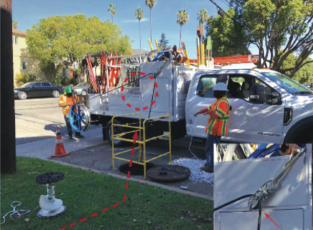How to “PULL” Fiber Optic Cable Correctly
1st Sep 2022
Cable installers always talk about “pulling” fiber optic cable because that is how they install underground cable in conduit. In most cities, that is how the majority of cable is installed. A duct is available from point A to point B, a pull tape is blown in, a fiber optic cable is attached to it and the cable is pulled through the duct. Sounds simple, doesn’t it.
Maybe not. Recent observations and conversations with more than a few people in the fiber optic business have indicated that the basic process is not well understood by some contractors. This crew I photographed near my home (below), were pulling fiber in a duct one block long. What they are currently doing is likely damaging cables, if not breaking fibers during the process, likely compromising the long-term reliability of the cable and fibers.
Outside plant (OSP) fiber optic cable is designed to be pulled into ducts during installation. Every cable has three specifications that the installer must understand before beginning the installation of the cable to prevent damage, maximum pull tension, bend radius, and crush loading.
 |
|
|
These installers are pulling a cable larger than 1/2 inch diameter over a pulley about 5 inches in diameter when they should be using a pulley at least 20 inches in diameter (see red circle). |
Pull tension is fairly obvious. The cable is designed to be pulled and the maximum pulling tension it can withstand is specified. For OSP cables, that is usually around 600 pounds of tension. To withstand this tension, the pull tape must be attached to the cable properly.
For all but the shortest runs, a swivel pulling eye is needed to prevent the cable from twisting when pulled. Pulling eyes can also be specified to limit pulling loads; when a maximum tension, like 600 pounds is reached, the swivel breaks. Then the cable must be pulled out and tried again, this time with some lubrication.
Long pulls are generally done with a powered capstan. A pulling wheel that monitors and limits tension to prevent exceeding the tension limit of the cable. If tension becomes high, lubrication is applied.
Bend radius is very important and more likely to be violated and more likely to damage the cable and the fibers in it. Bending the cable too tightly can be done by pulling the cable at the wrong angle out of a duct or across a pulley that is too small. Most fiber optic cables are specified with a minimum bend radius of 20 times the cable diameter when under tension during a pull or 10 times the cable’s diameter when no longer under tension after installation.
With a typical fiber cable diameter around 1/2 inch (12mm), the minimum bend radius under tension is 10 inches. That means any pulleys or capstans being used to pull the cable has to be 20 inches diameter – it’s bend radius, remember and the diameter of a round object is 2 times the radius.
These installers are pulling a cable larger than 1/2 inch diameter over a pulley about 5 inches in diameter when they should be using a pulley at least 20 inches in diameter (see red circle). As the cable is pulled over that small pulley, the fibers are being crushed and the cable structure itself may permanently be damaged.
There is only one way to prevent damage to fiber optic cable during installation. installers must be properly trained and certified.
Bend radius limits can also be violated easily when pulling the cable out of the conduit if the tension is applied at an angle as shown by the red dotted line above. Special hardware exists to provide a smooth radius for the cable or, if not available, one can often use plastic ducts to create a bend-radius limiter.
A problem we have encountered is the installers use hardware that is not intended for fiber optic installation. Rope and many other types of cable can withstand tighter bending than fiber, so the hardware is smaller and potentially deadly to fiber optic cable. That small pulley used above was probably intended for rope.
The final spec is crush loads. Copper power cables are much less susceptible to damage from crush loads than fiber cable. We’ve seen photos of crews installing fiber standing on the cable or even driving vehicles over it. That can be fatal to fiber.
Incidents like this can be very costly. There is only one way to prevent damage to fiber optic cable during installation. Installers must be properly trained and certified.
